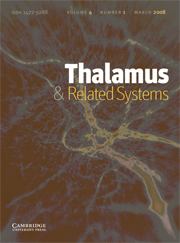Crossref Citations
This article has been cited by the following publications. This list is generated based on data provided by
Crossref.
Parker, Philip R. L.
Cruikshank, Scott J.
and
Connors, Barry W.
2009.
Stability of Electrical Coupling despite Massive Developmental Changes of Intrinsic Neuronal Physiology.
The Journal of Neuroscience,
Vol. 29,
Issue. 31,
p.
9761.
Lee, Seung‐Chan
Cruikshank, Scott J.
and
Connors, Barry W.
2010.
Electrical and chemical synapses between relay neurons in developing thalamus.
The Journal of Physiology,
Vol. 588,
Issue. 13,
p.
2403.
Haas, Julie S.
Zavala, Baltazar
and
Landisman, Carole E.
2011.
Activity-Dependent Long-Term Depression of Electrical Synapses.
Science,
Vol. 334,
Issue. 6054,
p.
389.
Crunelli, Vincenzo
Lőrincz, Magor L.
Errington, Adam C.
and
Hughes, Stuart W.
2012.
Activity of cortical and thalamic neurons during the slow (<1 Hz) rhythm in the mouse in vivo.
Pflügers Archiv - European Journal of Physiology,
Vol. 463,
Issue. 1,
p.
73.
Haas, Julie S.
and
Landisman, Carole E.
2012.
Bursts modify electrical synaptic strength.
Brain Research,
Vol. 1487,
Issue. ,
p.
140.
Zainol, Farrah Dilla
Thammawongsa, Nopparat
Mitatha, Somsak
Ali, Jalil
and
Yupapin, Preecha
2013.
Nerve communication model by bio-cells and optical dipole coupling effects.
Artificial Cells, Nanomedicine, and Biotechnology,
Vol. 41,
Issue. 6,
p.
368.
Niculescu, D.
and
Lohmann, C.
2014.
Gap Junctions in Developing Thalamic and Neocortical Neuronal Networks.
Cerebral Cortex,
Vol. 24,
Issue. 12,
p.
3097.
Melnikova, E. V.
Shmonin, A. A.
Paramonov, N. M.
and
Mishchenko, K. A.
2016.
The role of connexin structures (gap-junction and hemichannels) in the pathogenesis of ischemic brain damage: status update on the problem.
Regional blood circulation and microcirculation,
Vol. 15,
Issue. 3,
p.
4.
Carvalho, Sandra
French, Melanie
Thibaut, Aurore
Lima, Wilrama
Simis, Marcel
Leite, Jorge
and
Fregni, Felipe
2018.
Median nerve stimulation induced motor learning in healthy adults: A study of timing of stimulation and type of learning.
European Journal of Neuroscience,
Vol. 48,
Issue. 1,
p.
1667.
Fernandez, Laura M. J.
and
Lüthi, Anita
2020.
Sleep Spindles: Mechanisms and Functions.
Physiological Reviews,
Vol. 100,
Issue. 2,
p.
805.
O’Reilly, Christian
Iavarone, Elisabetta
Yi, Jane
and
Hill, Sean L.
2021.
Rodent somatosensory thalamocortical circuitry: Neurons, synapses, and connectivity.
Neuroscience & Biobehavioral Reviews,
Vol. 126,
Issue. ,
p.
213.
Edlow, Brian L.
Sanz, Leandro R. D.
Polizzotto, Len
Pouratian, Nader
Rolston, John D.
Snider, Samuel B.
Thibaut, Aurore
Stevens, Robert D.
Gosseries, Olivia
Akbari, Yama
Bleck, Thomas P.
Diringer, Michael N.
Foreman, Brandon
Hartings, Jed A.
Helbok, Raimund
Hemphill, J. Claude
Ling, Geoffrey S. F.
Mayer, Stephan A.
McNett, Molly
Monti, Martin M.
Olson, DaiWai M.
Owen, Adrian M.
Park, Soojin
Provencio, J. Javier
Puybasset, Louis
Vespa, Paul
Wagner, Amy
Whyte, John
and
Ziai, Wendy
2021.
Therapies to Restore Consciousness in Patients with Severe Brain Injuries: A Gap Analysis and Future Directions.
Neurocritical Care,
Vol. 35,
Issue. S1,
p.
68.
Fricker, Brandon
Heckman, Emily
Cunningham, Patrick C.
Wang, Huaixing
and
Haas, Julie S.
2021.
Activity-dependent long-term potentiation of electrical synapses in the mammalian thalamus.
Journal of Neurophysiology,
Vol. 125,
Issue. 2,
p.
476.
Wang, Huaixing
and
Haas, Julie S.
2021.
GABABR Modulation of Electrical Synapses and Plasticity in the Thalamic Reticular Nucleus.
International Journal of Molecular Sciences,
Vol. 22,
Issue. 22,
p.
12138.
Lippert, Julian
and
Guggisberg, Adrian G.
2023.
Diagnostic and Therapeutic Approaches in Neurorehabilitation after Traumatic Brain Injury and Disorders of Consciousness.
Clinical and Translational Neuroscience,
Vol. 7,
Issue. 3,
p.
21.
Dervinis, Martynas
and
Crunelli, Vincenzo
2024.
Sleep waves in a large‐scale corticothalamic model constrained by activities intrinsic to neocortical networks and single thalamic neurons.
CNS Neuroscience & Therapeutics,
Vol. 30,
Issue. 3,
Traub, Roger
and
Draguhn, Andreas
2024.
Brain Leitmotifs.
p.
95.

